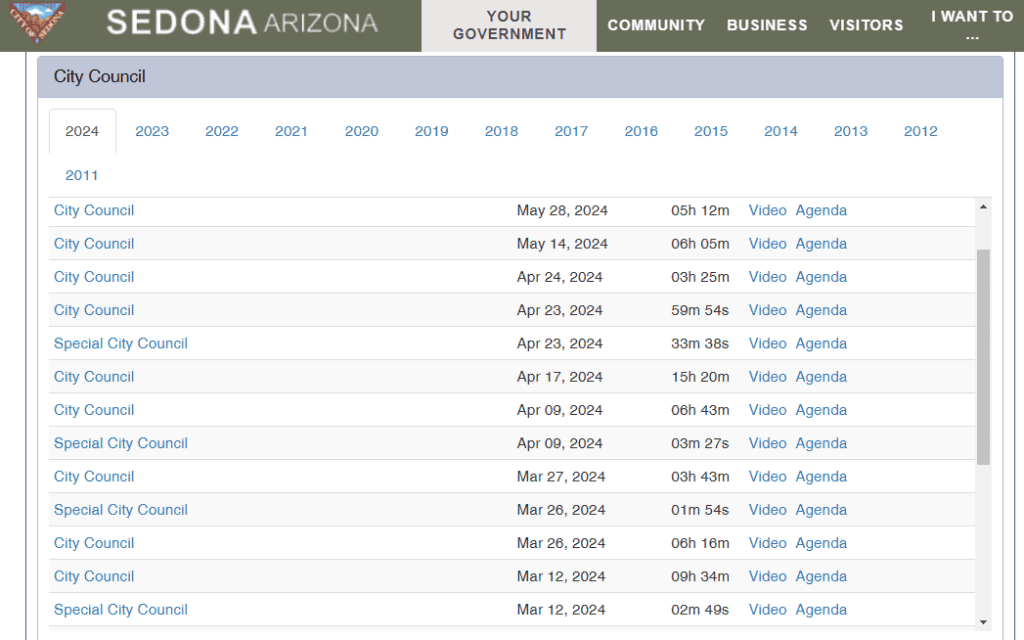As the voice of Sedona and the Verde Valley, and Sedona’s newspaper of record for the last 60 years, we’re no stranger to filing public records requests with local, county and state governments, as well as federal agencies whose activities affect the area that we cover.
Many of these requests are done with a story in the works, but sometimes we’re just curious.
And so it was with our recent request to the city of Sedona to see how many people watch the meetings our staff is paid to watch and report. This came after several of us watched the marathon meeting about the Uptown parking garage last month and we wondered how many other residents did, too.
As Tim Perry reported in the May 31 edition, the average number of views for Sedona council meetings is 18, and for Planning and Zoning Commission meetings, the average is 13.2.
As Perry detailed, the numbers are higher for hot-button issues, like 465 viewers since last year for the Sunset Lofts and Sedona Airport discussion Aug. 8, but overall the numbers are pretty low for local government meetings.
Some watch meetings live, as I do, and the city did not provide those numbers, as they are not recorded, but I trust I’m probably an outlier.
Council chambers are sometimes, but very rarely, filled to capacity, with most attendees waiting to speak their minds during the call to the public, then departing after hearing the agenda item in which they were interested, or sometimes without speaking at all if they’ve been waiting for hours.
So if the total attendance is around 45 — 18 online, 20 in the room, and half a dozen live, why do meetings go so long with council members pontificating for hours on end?
A long meeting doesn’t make democracy any better; council members are not writing a new constitution to last the ages, they’re approving building plans, signing a service contract or distributing someone else’s tax dollars.
Who benefits?
Residents apparently are not watching entire meetings; the average length of time spent viewing even the most controversial meetings was 148 seconds — not minutes, seconds; yes, we had to double-check that — long enough to pull up the video page, scroll to the call to the public, see what a neighbor or friend had to say, then leave the city’s website.

Certainly council must do the people’s business and discuss details about projects and programs, but they’re not addressing other council members in actual debate to persuade anyone to change their vote. Council members receive and supposedly read the 100- to 250-page agenda packet before each meeting and many, if not all, speak with the city manager beforehand to get their questions answered.
If they already know the details from the packet, listen to the presentation during the meeting and give direction to make a few tweaks, there’s no reason council members can’t concisely list their reasons about how they will vote and why and then move on to the next item. It appears from the city’s numbers that residents don’t care about hearing the meandering way each council member came to their decision, especially if that decision is predictably unanimous.
One could argue that they are doing so to get reelected, but those numbers don’t pan out either. Of the 62 people elected or appointed to council since the city’s incorporation in 1988, only 16 have run for reelection (three more than once), with the rest serving one term and stepping aside. Of those 16 council members’ 25 reelection campaigns, 21 were successful. Granted, an 84% reelection rate for Sedona incumbents is far less the 98% reelection rate for Congress, but it’s nothing to sneeze at.
Perhaps council members are trying to speak to their constituents? But if they were, their supporters would watch more frequently and for longer.
That said, most voters tell us that they decides who they will vote for based on stories and ads in our newspaper and how candidates answer questions at community forums and debates, not on a rambling monologue at a council meeting three years before election day.
The city of Cottonwood has 30% more residents, a budget 50% bigger and — even with its current council involved in a civil war — its meetings run just over an hour. They only approach two hours if there are a lot of speakers during the call to the public.
Generally, at least in other towns in the Verde Valley, a long meeting about only a handful of issues is due to ebb and sway as council members debate the pros and cons in an attempt to persuade others on the dais to switch their votes. But it’s fascinating, from an anthropological perspective, to see such lengthy meetings still resulting in unanimous 7-0 votes.
For years, Sedona City Council members past and present, both in office and afterward, as well as city managers and staff, have complained about the length of meetings. We thought, erroneously it seems, that residents wanted long meetings, but that does not appear to be the case. Instead, residents seem to prefer to find out what happened from our newspaper, since that way, they can absorb the facts in five to 10 minutes rather than watching hours of vague discussion.
If meetings were a digestible length and didn’t ruin someone’s evening plans, more residents might actually watch them or attend in person, but it’s highly likely many concerned residents see the “06h 05m,” “06h 28m” or “09h 34m” numbers under the meeting “duration” column and decide a council or P&Z meeting is not worth their time. They’d rather watch Netflix.
Democracy ultimately suffers.
If you’re interested in Perry’s story, read the May 31 edition or visit redrocknews.com. It won’t take you but a few minutes, we promise. Enjoy.
Christopher Fox Graham
Managing Editor